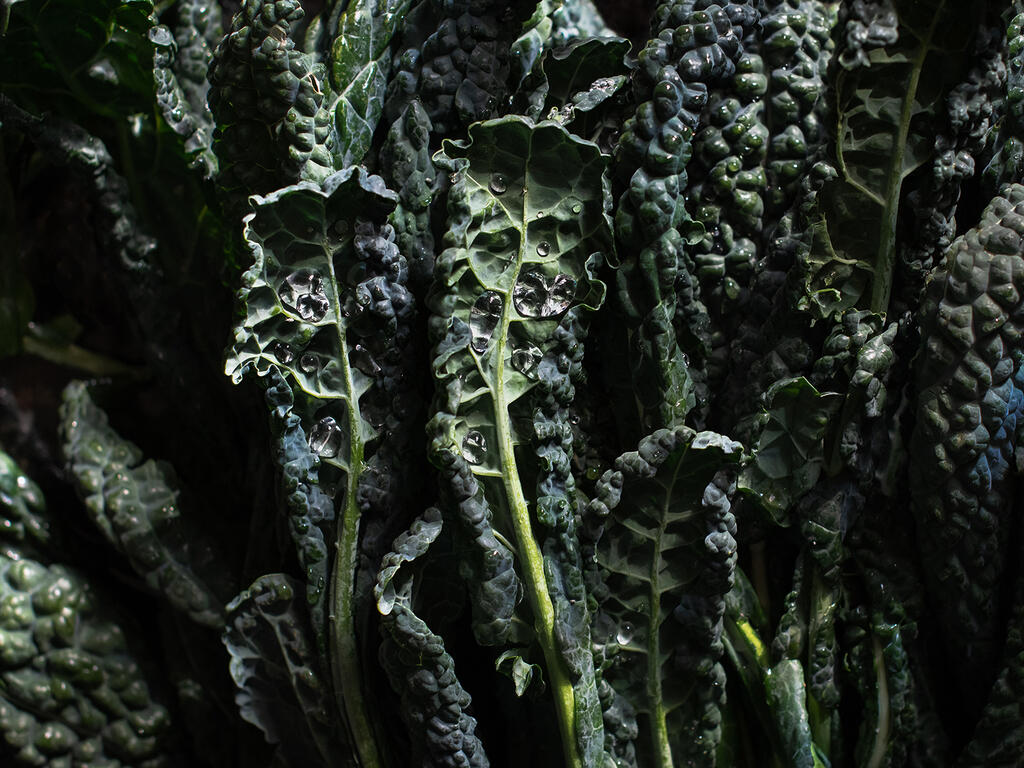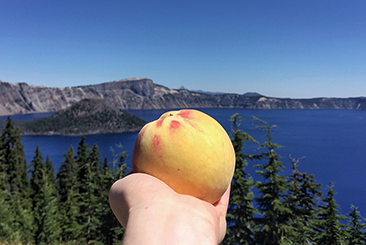A.O.C.s Long-Cooked Cavolo Nero (Black Kale)

RECIPE UPDATED 2/9/23
I have a fondness for restaurant and bakery cookbooks. Perhaps it's the tried-and-true nature of recipes that have been tweaked and served hundreds if not thousands of times, but generally I find they are the most referenced books on my shelves. Zuni Cafe, Mozza, Gjelina, Tartine (updated edition linked - original is out of print), Roberta's, and Violet Bakery to name a few of many titles. A.O.C. is a restaurant we frequent yet somehow their cookbook had escaped my notice so I promptly remedied that oversight.
One of the first recipes to catch my eye was the minimalist dish Long-Cooked Cavolo Nero -- a favorite of Chef Suzanne Goin. Anchored by quality ingredients and a little patience, the finished kale is greens living their best life with the kick of heat, gently caramelized onions, and lovely texture. It defies the vegetable's reputation of being tough or bitter.
A.O.C.'s kale has become a star component in my kitchen thanks to its versatility and freezeability. There have been weeks where I find myself using it several days in a row for rice bowls, colcannon, eggs, breakfast sandwiches, or on its own as a side. I can get about 4 to 5 portions from the recipe below and just freeze the servings in bundles.
The quick lunch I often turn to is some variation of Koda Farms Kokuho Rose brown rice (also from the freezer), A.O.C. kale, Boon sauce, and a fried egg. Bachan's Japanese BBQ Sauce found its way into my stocking over the holidays so I've added that as well. Serve the kale with soba noodles, a poached egg, and chili crisp or it would be excellent in Farro & Black Rice With Kale & Pine Nuts which is another delicious dish from the cookbook. I could go on.
Around the Dinner Table
Fit for Cows
Kale is a controversial ingredient. Some insist it's just cover crop fit for cows while others, like Joshua McFadden of Six Seasons fame, have built a career on serving it. David Fairchild was the botanist who introduced kale to America and even he didn't like it.
I don't intend to wear a "Kale Junkie" t-shirt but I do enjoy a good plate of cover crop and feel the vegetable is misunderstood. Similar to brussels sprouts, kale probably falls victim to poor preparation.
To that point, there are a number of recipes on the internet that call for massaging and slightly crushing kale to tenderize the greens and reduce bitterness. Cook's Science offers a different take and suggests that massaging kale can actually be part of the problem.
That's because crushing the leaves breaks down the cell walls of two important chemicals naturally present in kale---the myrosinase enzyme and glucosinolates. When those walls deteriorate, the two chemicals interact and create a new, bitter compound that's biologically designed to fend off hungry enemies.
Humans and kale are similar in that patience makes us our best selves so I prefer braising or other long cooking methods. With that said, there's hope for anyone wanting to enjoy a trough of raw greens. If you massage, chop, then wash the kale (in that order), the bitter compound mentioned above washes off.
No Autographs, Please
Kale is often called a superfood when it's really just a healthy vegetable with a clever publicist. The nutrient-rich member of the brassica family has been in culinary circulation since Roman times and -- without any art history background -- I'm going to spread unsubstantiated information that the greens in this "unswept floor" Circa 200 AD look a lot like kale. Maybe it's a different leafy green, but the additional photos I came across make a case for kale. I find myself pre-occupied with the novelty of unswept floor mosaics since discovering them and may need to install one in a future home.
Mark Bittman puts is more delicately when discussing superfoods:
The active ingredient in a healthful diet is the whole magilla, from simple soup to nonexotic nuts. Claims for superfoods are superficial, supercilious, and superfluous. Only spend extra on a superfood when you can carry it home in the saddlebag of your sparkly unicorn.
Party Like It's Grünkohlessen
If kale is king (or queen) in your book, here's a town that stands with you.
What does A.O.C. stand for?
Appellation d'Origine Contrôlée or A.O.C. is a French certification for agricultural products that have a controlled designation of origin, quality, and style. Cheese, butter, and wine are a few of the products that you may find with an A.O.C certification. Italy has a similar designation -- D.O.P. -- which includes the queen, Parmigiano-Reggiano.
All of these years and I had no idea what A.O.C. stood for.
Original Vs. Adapted
Lemon & Garlic
As I was prepping the kale, Nancy Silverton's Oily Garlicky Spinach from Mozza at Home popped into my head. I ended up lifting a few elements from it including lemon peel for brightness and a bump in the garlic quantity. The brightness of the citrus wakes everything up so definitely throw that in.
Onion
This isn't really an adaptation as much as a note. The pictured finished dish was my first batch of A.O.C. Long-Cooked Cavolo Nero and doesn't include onion. The story behind that omission isn't worth telling. Some day I'll photograph another batch and update this post. At this point, I don't make the recipe without onion as it adds an essential sweet/savory layer. The onion's color will be golden to caramel brown when you're done cooking.
Recipe Tips
Me Time
This recipe -- especially the kale prep -- lends itself to listening to a podcast or favorite album. I was trimming kale leaves one afternoon and recall playing Short Wave: Your Multivitamin Won't Save You which was unintentionally fitting. Supplements may not be the answer but perhaps my superstar "superfood" kale that I brought home on my sparkly unicorn is.
Make Ahead
I prefer to blanch and dry my kale the day before as it just makes for an easier process. Layer with some paper towels and refrigerate in an airtight container until ready to use.
Resist
The only time this dish didn't turn out to my liking was when the oil to kale ratio wasn't right. The mouthfeel and taste were a bit oily though it was still entirely edible. I've included weight measurements for the kale and onions to help you avoid my mistake. The pan should barely be slicked with oil while the kale cooks. If you're struggling with too much sticking, the heat may be too high so try to adjust that down before adding more oil than the recipe suggests.
Are We There Yet
There may be a point while making this recipe that you hear a bit of sizzling but look at the pan and wonder if anything is actually happening. Once you give it a toss you'll see the magic happening underneath the surface -- little bits of the kale starting to crisp and darken, a poof of steam that wafts up. Trust in the magic of time.
Kale Stems
The kale stems are usually discarded when making this recipe but as an ingredient they're delicious and taste similar to broccoli. The key is to blanch and cook them in a way that breaks down the fibrous texture. I haven't nailed a go-to recipe but here are my current tips if you want to make use of them:
- Blanch until the stems are flexible but not entirely mushy inside.
- Stir-frying is a solid cooking method for kale stems but it helps to cut them into 1-inch pieces. For one experiment, I used a Kinpira approach (stir fry then quickly simmer in a sugar/soy sauce blend) and left the stems whole because I had a grand vision for the presentation. The flavor was quite tasty but the whole stems had me looking like a cow whilst chewing.
- Roasting didn't work out for me -- maybe the heat was too low -- so if anyone has success with that I would love to hear about it.
Farmers | Artisans
I make an effort to source my food from California artisans with a special focus on the Santa Monica Farmers Market. Below is a list of the folks who contributed to this dish.
- Coleman Family Farms // Cavolo Nero (Black Kale)
- JJ's Lone Daughter Ranch & Polito Family Farms // Citrus
- MIlliken Family Farms // Garlic
- Apricot Lane Farms & Coleman Family Farms // Rosemary
 Coleman Family Farms Cavolo Nero - Santa Moncia Farmers Market
Coleman Family Farms Cavolo Nero - Santa Moncia Farmers Market
Cookbooks Referenced
Tools
- Rösle Mandoline/Slicer - This tool has a beautiful design and is really easy to use and clean. I reach for it often, especially when making quick pickled recipes (here, here).
- Salad Spinner - I'm not sure how the salad spinner I have migrated into my life but it has been with me for many years and spins me right 'round, baby, right 'round. The linked item is the same brand and seems to be an updated version with a stainless bowl that offers a 2-in-1 package. Spin the greens and then use the bowl to toss them with your dressing of choice. I don't recommend using plastic with vinegar-based ingredients. The string and handle is a sensible design since it means you don't have to pump or crank to get the salad to whirl around. There's a a non-stainless version as well.
Ingredients
- 3 large bunches cavolo nero (black kale), about 685 grams or 1 1/2 pounds (also goes by Tuscan, black, lacinato, and dinosaur) Note: I ended up with 12 ounces of leaves after prep.
- 1/4 cup quality olive oil + 2 tablespoons divided
- 2 dried árbol chiles, broken in half
- 4 cloves garlic, sliced very thin, 15 grams or 1/2 ounce after prep Note: I use a mandoline for both the garlic and onion.
- 1 small/medium yellow onion, thinly sliced, 5 ounces or 140 grams after prep
- 5-inch sprig fresh rosemary Note: I'm a big fan of rosemary and sometimes use two sprigs.
- 4 to 5 strips lemon zest, 9 grams or 1/4 ounce which is about 3/4 of a medium lemon
- Diamond kosher salt
- Freshly ground pepper
Instructions
Trim, Blanch, and Relax
You can stop after the blanching process and cook the kale the next day if preferred.
- Bring a large pot of water plus a couple tablespoons of salt to a boil. While that's working, fill a large bowl with ice water and set aside.
- Turn on your favorite album or podcast and trim the leaves away from the ribs then discard the ribs or set them aside for another use. See Recipe Tips for some thoughts on the latter.
- Once the water is at a boil, blanch half of the kale for two minutes, agitating constantly to clean all the nooks and crannies. Transfer to the ice bath and swoosh around. Repeat with the remaining kale. If you plan to use the stems, blanch them at the end.
- Gently squeeze the kale and shake off any excess ice water (a salad spinner is helpful), then spread the leaves out on a clean dish towel to air dry a bit. If storing in the refrigerator, layer a few paper towels between the leaves and place in an airtight container. Otherwise, forge ahead.
Mise en Place
- Prep the rest of your ingredients.
Sizzle
- Heat a large skillet or similar over medium-low for 3 to 5 minutes -- my preference is carbon steel. Add 1/4-cup olive oil along with the garlic, broken árbol chile, lemon peel, and rosemary then gently cook until wonderfully fragrant which takes about 5 minutes. The garlic should barely be whispering -- as if the slices are telling each other secrets -- since the idea is to infuse rather than brown or fry. On that note, lower the heat if the garlic is browning.
- Add the onion, 1/2 teaspoon of salt, a few cranks freshly ground pepper, then stir to coat. Cook until the onions are translucent, about 10 minutes. The onions are going to sweat and offer some protection for the garlic so at this point I turn my heat up a touch which makes the sizzle a little more noticeable. The idea is to break the ingredients down so they can caramelize, not fry them so hard that they turn dark brown. You're building the base for your flavor here so take your time. Taste an onion - it should be taking on a little heat and there will be a hint of sweetness thanks to the beginning of caramelization.
- Fold in 1/3 of the kale, gently tossing to coat all of the leaves. Cook for a minute to wilt slightly then add another 1/3 of the kale plus 1 tablespoon of olive oil. Gently toss to coat and cook for a minute or two until wilted. Repeat with the remaining kale plus 1 additional tablespoon of olive oil. Season with 1/4 teaspoon salt and a few cranks of freshly ground pepper. Cook over low/medium-low heat for 50 minutes to an hour, tossing from time to time to ensure all of the greens are getting some contact with the pan. The kale should be lightly sizzling and the pan will be thinly slicked with oil.
Status Check-in: At about 35 minutes, some of the onions will be developing color and may gently stick - just swoosh a couple pieces of kale around on that spot and pick up any fond that is forming. With that said, the pan shouldn't build up much fond if your heat is low enough. If the rosemary is falling apart, just take it out. You're almost there.
- In roughly 50 minutes to an hour, the kale will have blackened and/or crisped in spots and have a tender texture. Take a taste and adjust the salt and pepper to your liking.
Storage
Enjoy or cool and store. I find the flavor is even better on day two. The kale can be refrigerated for a couple of days or freeze it in bundles. Discard the rosemary, lemon, and chile before storing.
Newsletter
Subscribe at the bottom of this page for the Chic Eats roundup. It includes new and updated recipes along with a grab bag of unique content that was interesting enough to share around the dinner table.







